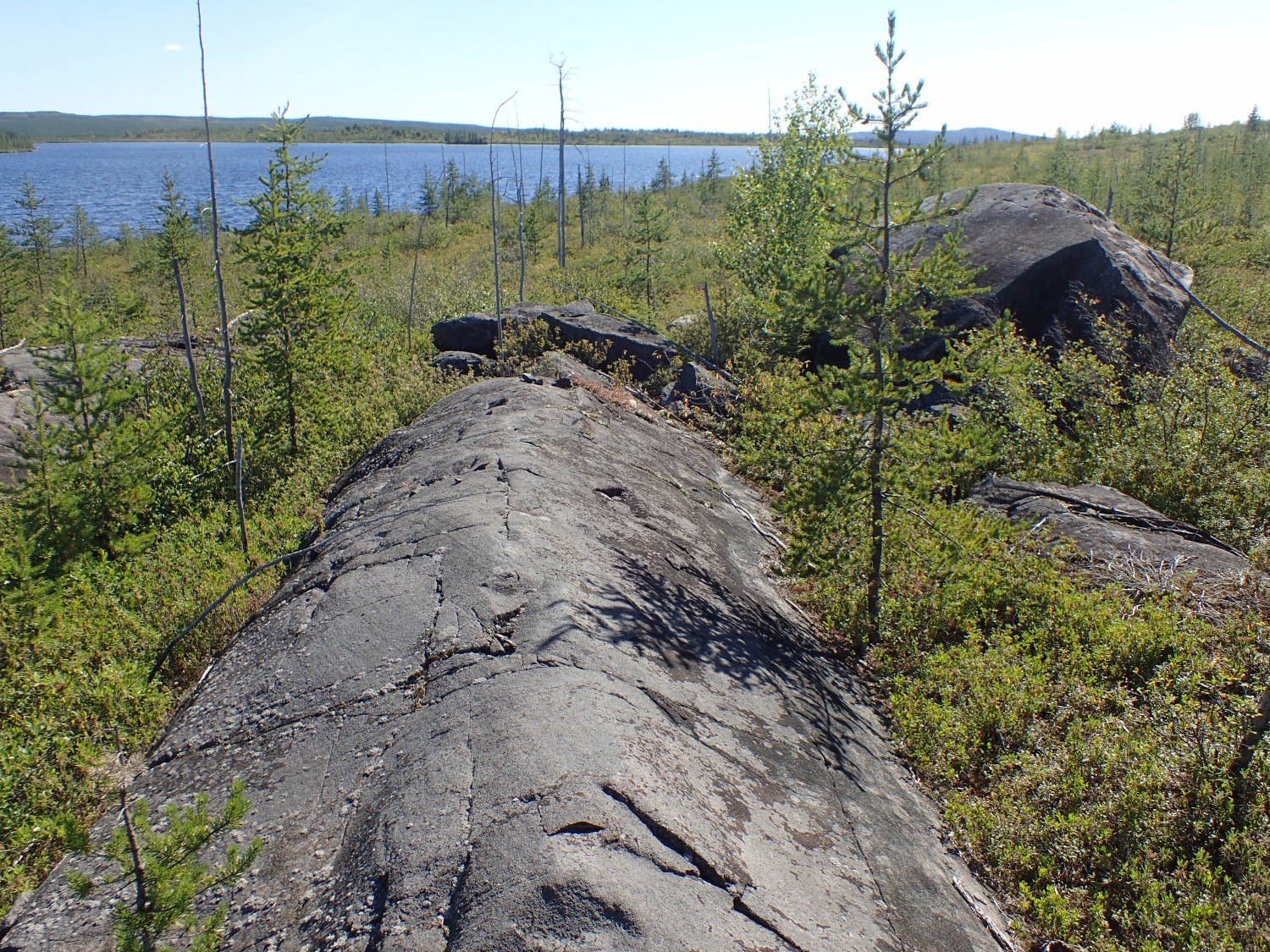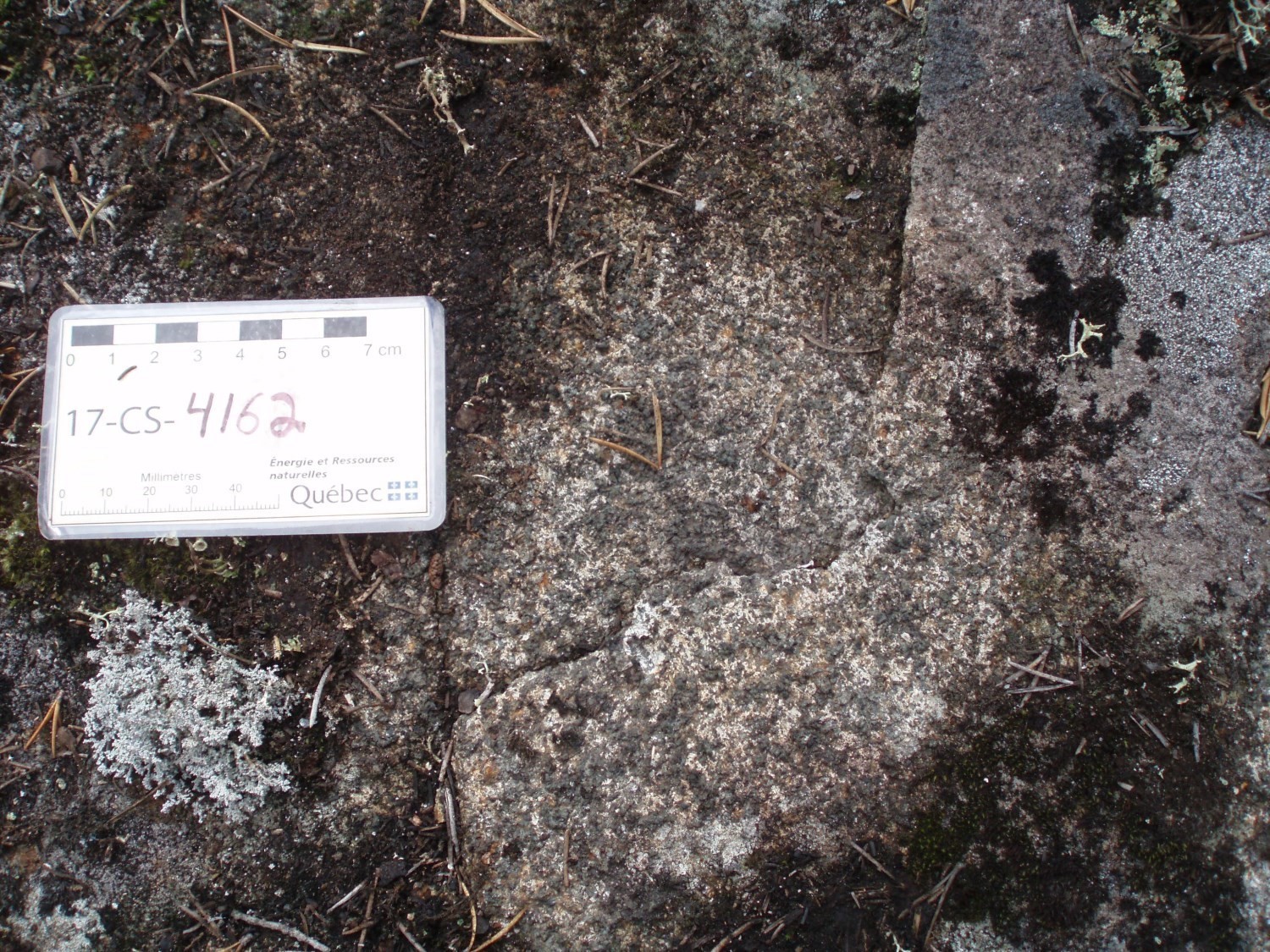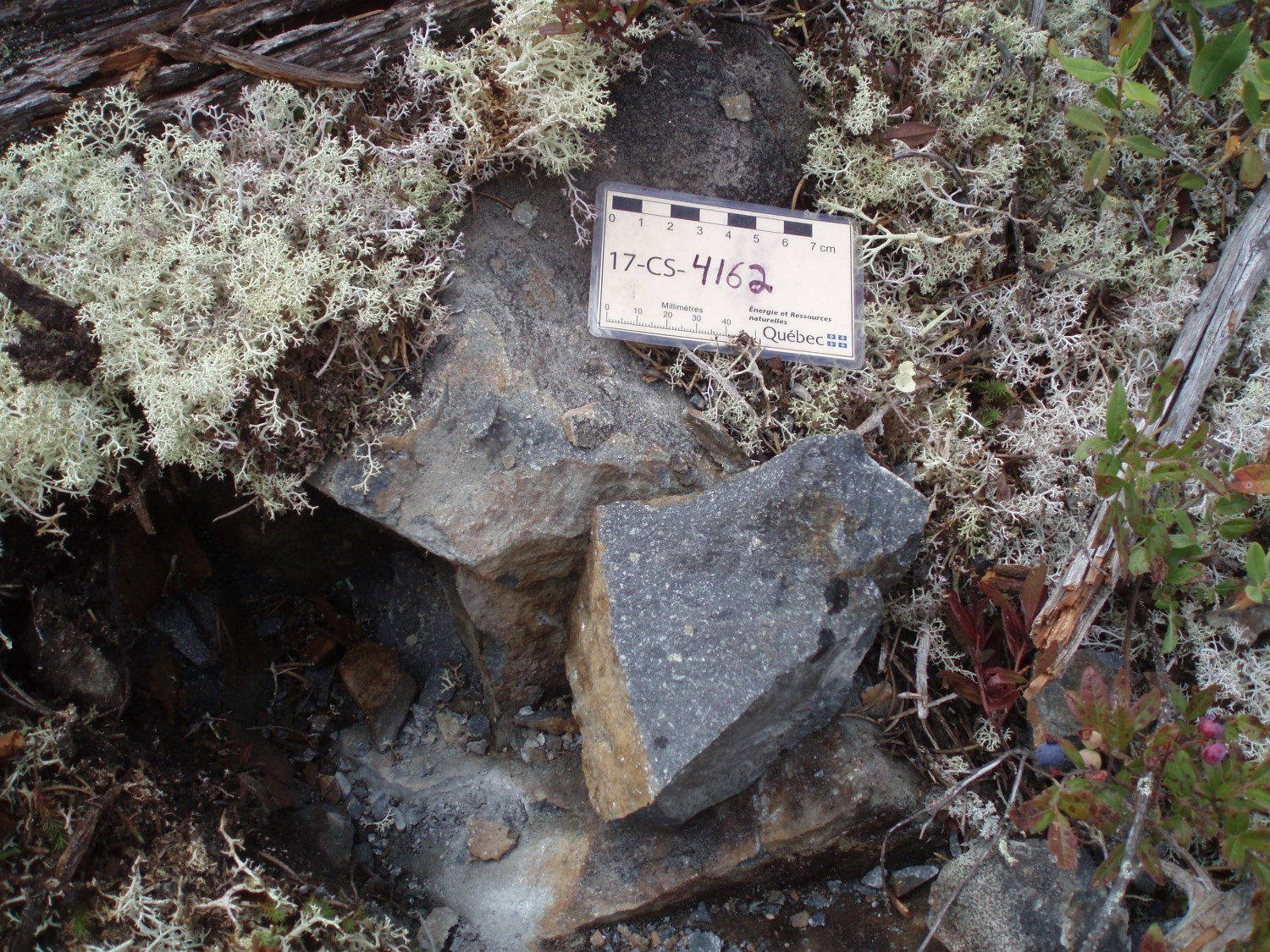
DISCLAIMER: This English version is translated from the original French. In case of any discrepancy, the French version shall prevail.
| Author(s): | Fahrig et al., 1965 |
| Age: | Paleoproterozoic |
| Stratotype: | None |
| Type area: | District of Matachewan, Ontario (NTS sheet 041P15) |
| Geological province: | Superior Province |
| Geological subdivision: | Abitibi, Nemiscau, Opatica, La Grande, Pontiac, Wawa, Quetico and Wabigoon subprovinces |
| Lithology: | Diabase |
| Category: | Lithodemic |
| Rank: | Lithodeme |
| Status: | Formal |
| Use: | Active |
None
Background
The Canadian Shield diabase dyke swarms have been the subject of several works. The Matachewan Dyke Swarm is a family of diabase dykes that cuts the Canadian Shield north-south, first identified in the Matachewan area (NTS sheet 041P15). This dyke swarm was the subject of paleomagnetic (Fahrig et al., 1965), geochemical (Condie et al., 1987; Buchan et al., 2007) and geochronological (Fahrig and Wanless, 1963; Gates and Hurley, 1973; Heaman, 1997) studies.
Beausoleil and Bélanger (2005a and b) and Beausoleil and Goutier (2005a and b) assigned the diabase dykes in the sheet 32D02 to the “Dyke of Preissac” unit. In their extensions in the adjacent sheets, these dykes belong to the Abitibi Dykes and the Matachewan Dyke Swarm. The reassignment is carried out as part of the production of this stratigraphic sheet and the “Dyke of Preissac” unit is abandoned.
Description
Dykes are characterized by a positive relief and a positive linear aeromagnetic anomaly. They are clearly visible on aeromagnetic maps because of their high magnetic susceptibility. They are not deformed and cut structural grain at high angles. The thickness of these dykes ranges from a few metres to a few tens of metres. The rock is brownish or orange-beige in altered surface and dark green to bluish grey in fresh exposure, massive and highly magnetic. The narrow dykes, along with contact margins of the thickest dykes, look like fast cooling zones and show thin plagioclase needles in an aphanitic matrix. There is an increase in grain size from the border to the centre of the dykes. The central part of the dykes, which is gabbroic to gabbronoritic, is medium to coarse grained to porphyritic. One of the main characteristics of the Matachewan Dyke Swarm is the porphyritic texture (plagioclase phenocrystals). Ophitic or subophitic texture is also often observed. The rock is composed of euhedral plagioclase laths whose interstitial spaces are filled by slightly chloritized pyroxene, as well as by an assemblage of magnetite, pyrite, chlorite, apatite and rare flakes of biotite.
The Matachewan Dyke Swarm is difficult to distinguish from the Lac Esprit Dykes because both have a north-south orientation. Buchan et al. (2007) were able to differentiate them through paleo-magnetic, geochemical and geochronological data.
Thickness and distribution
The map of Buchan and Ernst (2004) shows the distribution of all diabase dyke swarms in Canada. The Matachewan Dyke Swarm is located in the south and centre of the Superior Province (Quebec and Ontario). Specifically, they are found in the Abitibi, Opatica, Nemiscau, La Grande, Pontiac, Wawa, Quetico and Wabigoon subprovinces. Some of these dykes can be followed over 500 km. In the Rodayer Lake area (sheets 32K13, 32K14, 32N03 and 32N04), these dykes can be up to 60 m thick (Bandyayera and Daoudene, 2017).
Dating
Heaman (1997) conducted a geochronological study of baddeleyites and zircons collected from two Matachewan dyke samples and obtained ages of 2473 +16/-9 Ma and 2446 ±3 Ma. Fahrig and Wanless (1963) obtained an age of 2485 Ma from a total rock K-Ar analysis of a chilled margin sample of a Matachewan dyke. A Rb-Sr age of 2690 ±93 Ma was also obtained by Gates and Hurley (1973).
| Isotopic System | Mineral | Crystallization Age (Ma) | (+) | (-) | Reference(s) |
| U-Pb | Baddeleyite | 2473 | 16 | 9 | Heaman, 1997 |
| Baddeleyite and zircon | 2446 | 3 | 3 |
Stratigraphic Relationship(s)
The Matachewan Dyke Swarm cuts the southern and central Archean rocks of the Superior Province.
Paleontology
Does not apply.
References
Publications available through SIGÉOM Examine
BEAUSOLEIL, C., BÉLANGER, M., 2005a. Compilation géoscientifique – Géologie 1/20 000, 32D02-200-0101 – BAIE CARON. In : MRNF, 2010. CARTE(S) GÉOLOGIQUE(S) DU SIGEOM – feuillet 32D. CG SIGEOM32D, 56 plans.
BEAUSOLEIL, C., BÉLANGER, M., 2005b. Compilation géoscientifique – Géologie 1/20 000, 32D02-200-0102 – LAC VAUDRAY. In : MRNF, 2010. CARTE(S) GÉOLOGIQUE(S) DU SIGEOM – feuillet 32D. CG SIGEOM32D, 56 plans.
BEAUSOLEIL, C., GOUTIER, J., 2005c. Compilation géoscientifique – Géologie 1/20 000, 32D02-200-0201 – MCWATTERS. In : MRNF, 2010. CARTE(S) GÉOLOGIQUE(S) DU SIGEOM – feuillet 32D. CG SIGEOM32D, 56 plans.
BEAUSOLEIL, C., GOUTIER, J., 2005d. Compilation géoscientifique – Géologie 1/20 000, 32D02-200-0202 – LAC JOANNÈS. In : MRNF, 2010. CARTE(S) GÉOLOGIQUE(S) DU SIGEOM – feuillet 32D. CG SIGEOM32D, 56 plans.
BANDYAYERA, D., DAOUDENE, Y., 2017. Géologie de la région du lac Rodayer (SNRC 32K13-32K14-32N03 et 32N04-SE). MERN; RG 2017-01, 60 pages, 2 plans.
Other publications
HEAMAN, L.M., 1997. Global mafic magmatism at 2.45 Ga: Remnants of an ancient large igneous province? Geology; volume 25 (4), pages 299-302. https://doi.org/10.1130/0091-7613(1997)025<0299:GMMAGR>2.3.CO;2
FAHRIG, W.F., WANLESS, R.K., 1963. Age and significance of diabase dyke swarms of the Canadian Shield. Nature; 200, pages 934-937. https://www.nature.com/articles/200934a0
FAHRIG, W.F., GAUCHER, E.H., LAROCHELLE, A., 1965. Paleomagnetism of diabase dykes of the Canadian Shield. Canadian Journal of Earth Sciences; volume 2, pages 278-298. https://doi.org/10.1139/e65-023
BUCHAN, K.L., ERNST, R.E., 2004. Diabase dyke swarms and related units in Canada and adjacent regions. Commission géologique du Canada; Carte série « A » 2022A, 39 pages, 1 feuille. https://doi.org/10.4095/214883
GATES, T.M., HURLEY, P.M., 1973. Evaluation of RbSr Dating Methods Applied to the Matachewan, Abitibi, Mackenzie, and Sudbury Dike Swarms in Canada. Canadian Journal of Earth Sciences; volume 10, pages 900-919. https://doi.org/10.1139/e73-080
CONDIE, K.C, BOBROW, D.J., CARD, K.D., 1987. Geochemistry of Precambrian mafic dykes from the southern Superior Province of the Canadian Shield. Geological Association of Canada; Special Paper, vol. 34, pages 95-108.
BUCHAN, K.L., GOUTIER, J., HAMILTON, A., ERNST, R. E., MATTHEWS, W. A., 2007. Paleomagnetism, U–Pb geochronology, and geochemistry of Lac Esprit and other dyke swarms, James Bay area, Quebec, and implications for Paleoproterozoic deformation of the Superior Province. Canadian Journal of Earth Sciences; volume 44(5), pages 643-664. https://doi.org/10.1139/e06-124
Suggested Citation
Ministère de l’Énergie et des Ressources naturelles (MERN). Matachewan Dyke Swarm. Quebec Stratigraphic Lexicon. https://gq.mines.gouv.qc.ca/lexique-stratigraphique/province-du-superieur/essaim-de-dykes-de-matachewan_en [accessed on Day Month Year].
Contributors
|
First publication |
Emmanuel Caron-Côté, P. Geo., M.Sc. emmanuel.caron-cote@mern.gouv.qc.ca (redaction) Mehdi A. Guemache, P. Geo., Ph.D. (coordination); Simon Auclair, P. Geo., M.Sc. (critical review and editing); Céline Dupuis, P. Geo., Ph.D. (English version); Yan Carette (HTML editing). |




